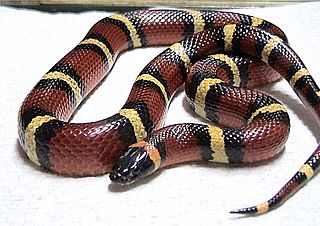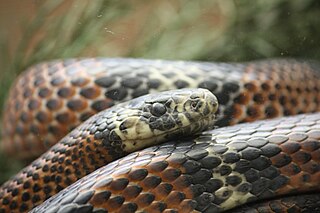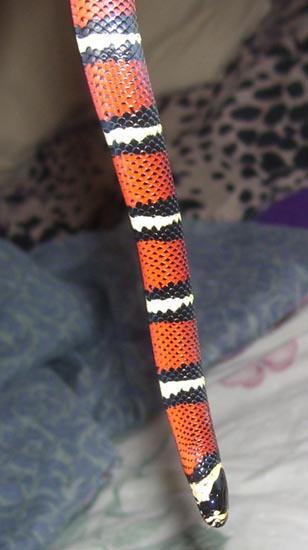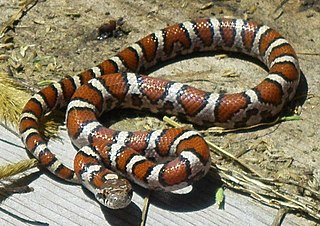
The corn snake, sometimes called red rat snake, is a species of North American rat snake in the family Colubridae. The species subdues its small prey by constriction. It is found throughout the southeastern and central United States. Though superficially resembling the venomous copperhead and often killed as a result of this mistaken identity, the corn snake lacks functional venom and is harmless. The corn snake is beneficial to humans because it helps to control populations of wild rodent pests that damage crops and spread disease.

The milk snake or milksnake, is a species of kingsnake; 24 subspecies are currently recognized. Lampropeltis elapsoides, the scarlet kingsnake, was formerly classified as a 25th subspecies, but is now recognized as a distinct species. The subspecies have strikingly different appearances, and many of them have their own common names. Some authorities suggest that this species could be split into several separate species. They are not venomous to humans.

Kingsnakes are colubrid New World members of the genus Lampropeltis, which includes 26 species. Among these, about 45 subspecies are recognized. They are nonvenomous and ophiophagous in diet.

The California kingsnake is a nonvenomous colubrid snake endemic to the western United States and northern Mexico, and is found in a variety of habitats. Due to ease of care and a wide range of color variations, the California kingsnake is one of the most popular snakes in captivity.

The scarlet kingsnake or scarlet milk snake is a species of kingsnake found in the southeastern and eastern portions of the United States. Like all kingsnakes, they are nonvenomous. They are found in pine flatwoods, hydric hammocks, pine savannas, mesic pine-oak forests, prairies, cultivated fields, and a variety of suburban habitats; not unusually, people find scarlet kingsnakes in their swimming pools, especially during the spring. Until recently, and for much of the 20th century, scarlet kingsnakes were considered a subspecies of the milk snake; however, Pyron and Bubrink demonstrated the phylogenetic distinction of this species and its closer relationship to the mountain kingsnakes of the southwestern United States. These largely fossorial snakes are the smallest of all the species within the genus Lampropeltis, usually ranging from 40 to 50 cm at maturity. The maximum recorded length is in Jonesboro, AR 76.2 cm (30.0 in). Hatchlings range in size from 8 to 18 cm .

Coral snakes are a large group of elapid snakes that can be divided into two distinct groups, the Old World coral snakes and New World coral snakes. There are 27 species of Old World coral snakes, in three genera, and 83 recognized species of New World coral snakes, in two genera. Genetic studies have found that the most basal lineages have origins in Asia, suggesting that the group originated in the Old World. While new world species of both genera are venomous, their bites are seldom lethal; only two confirmed fatalities have been documented in the past 100 years from the genus Micrurus. Meanwhile, snakes of the genus Micruroides have never caused a medically significant bite.

The gray-banded kingsnake, sometimes referred to as the alterna or the Davis Mountain king snake, is a species of nonvenomous snake in the family Colubridae. The species is endemic to the southwestern United States and adjacent Mexico. Some sources list two distinct subspecies of Lampropeltis alterna, as L. a. alterna and L. a. blairi differentiated by patterning and locale, but research has shown them to be color morphs of the same species.

Lampropeltis annulata, commonly known as the Mexican or Tamaulipan milksnake, is a non-venomous species of milksnake. The species is native to northwestern Mexico and some adjacent United States-Mexico border regions.

Lampropeltis triangulum andesiana, commonly known as the Andean milksnake, is an alpine subspecies of milk snake.

Cemophora coccinea copei, commonly known as the northern scarlet snake, is a subspecies of harmless colubrid snake that is native to the southern and eastern United States.

Nelson's milksnake is a subspecies of king snake that is found in Mexico from southern Guanajuato and central Jalisco to the Pacific Coast. It is also found on the narrow plains of northwestern Michoacán and on the Tres Marias Islands. The range of this snake appears to be tied to the proximity of watercourses, including ones utilized for irrigation and agriculture. It is a subspecies of the milksnake, Lampropeltis triangulum. It is similar in size to other king snakes, averaging 42 inches (110 cm) long, and like them, it is nonvenomous.

Lampropeltis triangulum sinaloae, commonly known as the Sinaloan milk snake, is an egg-laying subspecies of nonvenomous colubrid snake. It is one of the most commonly bred milk snakes in captivity. It is a fairly docile subspecies and will rarely bite. However, if handled, it may discharge a pungent smelling exudate from the cloaca as a warning. The Sinaloan milk snake inhabits the rocky and semi-arid drylands of southwestern Sonora, Sinaloa, and southwestern Chihuahua (Mexico).
Kenneth Lee Williams was an American herpetologist and author of books on the subject of snake biology and classification. Williams retired from teaching in Northwestern State University's biology department and received emeritus status in 2001. Williams is considered an authority on the milk snake and the herpetology of the Honduran Cloud Forest.

Lampropeltis getula, commonly known as the eastern kingsnake, common kingsnake, or chain kingsnake, is a harmless colubrid species endemic to the United States and Mexico. It has long been a favorite among collectors. Nine subspecies are currently recognized, including the nominate subspecies described here. All of these taxa had originally been described as distinct species and recognized as such for up to 101 years.

Lampropeltis triangulum gaigeae, commonly known as the black milk snake, is a non-venomous subspecies of milk snake. It is the largest known milk snake subspecies. Black milk snakes are found in the mountains of Costa Rica and Panama.

Cemophora coccinea coccinea, commonly known as the Florida scarlet snake, is the nominotypical subspecies of the scarlet snake. It is a nonvenomous colubrid snake that is endemic to the southeastern United States.

Lampropeltis triangulum hondurensis, commonly known as the Honduran milk snake, is an egg-laying subspecies of nonvenomous colubrid snake. It is one of the more commonly bred milk snakes in captivity and is one of the larger milk snakes, reaching a length of 5 feet.

Lampropeltis triangulum triangulum, commonly known as the eastern milk snake or eastern milksnake, is a subspecies of the milk snake. The nonvenomous, colubrid snake is indigenous to eastern and central North America.

Lampropeltis triangulum syspila, commonly known as the red milk snake or red milksnake, is a subspecies of the milk snake (Lampropeltis triangulum). The nonvenomous, colubrid snake is indigenous to the central United States.

Lampropeltis mexicana, the Mexican kingsnake, is a colubrid snake that is endemic to Mexico.


















